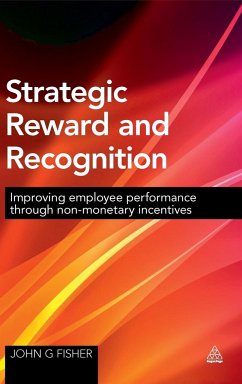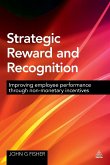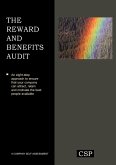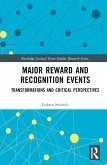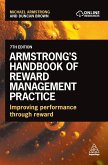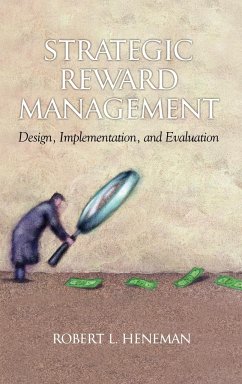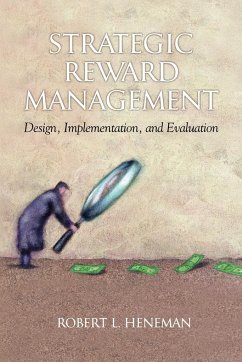John G Fisher
Strategic Reward and Recognition
Improving Employee Performance Through Non-Monetary Incentives
John G Fisher
Strategic Reward and Recognition
Improving Employee Performance Through Non-Monetary Incentives
- Gebundenes Buch
- Merkliste
- Auf die Merkliste
- Bewerten Bewerten
- Teilen
- Produkt teilen
- Produkterinnerung
- Produkterinnerung
Non-monetary incentives and recognition programmes are an area of employee motivation that is often overlooked. Yet, as Fisher's book reveals, a strategic focus on non-cash rewards can generate significant return on investment in terms of employee engagement, performance improvement and financial results. In the present economic context, with companies pushing to deliver more for less, it is a particularly pertinent issue. Strategic Reward and Recognition brings together theory and practice to guide HR professionals, consultants and senior leaders in developing the most effective programmes…mehr
Andere Kunden interessierten sich auch für
![Strategic Reward and Recognition Strategic Reward and Recognition]() John G FisherStrategic Reward and Recognition32,99 €
John G FisherStrategic Reward and Recognition32,99 €![The Reward and Benefits Audit The Reward and Benefits Audit]() Michael ArmstrongThe Reward and Benefits Audit68,99 €
Michael ArmstrongThe Reward and Benefits Audit68,99 €![Major Reward and Recognition Events Major Reward and Recognition Events]() Lukasz SwiatekMajor Reward and Recognition Events204,99 €
Lukasz SwiatekMajor Reward and Recognition Events204,99 €![Armstrong's Essential Skills for People Professionals Armstrong's Essential Skills for People Professionals]() Michael ArmstrongArmstrong's Essential Skills for People Professionals108,99 €
Michael ArmstrongArmstrong's Essential Skills for People Professionals108,99 €![Armstrong's Handbook of Reward Management Practice Armstrong's Handbook of Reward Management Practice]() Michael ArmstrongArmstrong's Handbook of Reward Management Practice212,99 €
Michael ArmstrongArmstrong's Handbook of Reward Management Practice212,99 €![Strategic Reward Management Strategic Reward Management]() Robert L. HenemanStrategic Reward Management119,99 €
Robert L. HenemanStrategic Reward Management119,99 €![Strategic Reward Management Strategic Reward Management]() Robert L. HenemanStrategic Reward Management85,99 €
Robert L. HenemanStrategic Reward Management85,99 €-
-
-
Non-monetary incentives and recognition programmes are an area of employee motivation that is often overlooked. Yet, as Fisher's book reveals, a strategic focus on non-cash rewards can generate significant return on investment in terms of employee engagement, performance improvement and financial results. In the present economic context, with companies pushing to deliver more for less, it is a particularly pertinent issue. Strategic Reward and Recognition brings together theory and practice to guide HR professionals, consultants and senior leaders in developing the most effective programmes for their organizations. It features examples of good practice from all over the world, from different sectors and from both large and small organizations, providing coverage of digital as well as in-person schemes.
Hinweis: Dieser Artikel kann nur an eine deutsche Lieferadresse ausgeliefert werden.
Hinweis: Dieser Artikel kann nur an eine deutsche Lieferadresse ausgeliefert werden.
Produktdetails
- Produktdetails
- Verlag: Kogan Page
- Seitenzahl: 258
- Erscheinungstermin: 11. April 2016
- Englisch
- Abmessung: 240mm x 161mm x 19mm
- Gewicht: 555g
- ISBN-13: 9780749479305
- ISBN-10: 0749479302
- Artikelnr.: 44973412
- Herstellerkennzeichnung
- Libri GmbH
- Europaallee 1
- 36244 Bad Hersfeld
- gpsr@libri.de
- Verlag: Kogan Page
- Seitenzahl: 258
- Erscheinungstermin: 11. April 2016
- Englisch
- Abmessung: 240mm x 161mm x 19mm
- Gewicht: 555g
- ISBN-13: 9780749479305
- ISBN-10: 0749479302
- Artikelnr.: 44973412
- Herstellerkennzeichnung
- Libri GmbH
- Europaallee 1
- 36244 Bad Hersfeld
- gpsr@libri.de
John G Fisher is CEO of FMI Group, a brand engagement consulting firm. He has over 30 years' experience in marketing communications, incentives, and performance improvement programs, specializing in the financial services sector. He is also the author of How to Run Successful Employee Incentive Schemes and Strategic Brand Engagement (both published by Kogan Page).
Acknowledgements
Introduction: Dealing with human beings
Incentives versus recognition
Does recognition really work?
The balanced scorecard
Bribery and corruption
The non-cash improvement dividend
Some definitions
Where to start?
Brand consistency
Performance improvement model
01 Why 'benefits' do not deliver performanceimprovement
Tax treatment of benefits and perks
The Motivation to Work by Frederick Herzberg (1959)
Only 'motivators' improve work performance
Does Herzberg's theory suggest more use of incentives?
Cash or non-cash?
Are there any other motivational theories to consider?
Benefits and perks are not the answer
02 Recognition and reward theory
What drives employees to perform better?
Experimental timeline
The rise of teamwork and affiliation
Basic physiological human needs
Murray's basic human needs
Maslow's hierarchy of needs
Victor Vroom and job satisfaction
Herzberg: two-factor theory
Goal setting and the quest for higher performance
Cottrell and teamwork
Goals and goal setting
Flow and job satisfaction
Performance and HR
Principles of corporate motivation
Key concepts in human motivation theory
03 Motivation in practice
Most programmes are sales-related
Other automotive incentive hybrids
IT and all things electrical
Some characteristics of sales incentives
Recognition programmes
Do reward and recognition programmes work?
04 The performance improvement programme model
The performance improvement model
Not all the elements are equal
Delivering the performance improvement model
Is performance improvement an HR or a marketing task?
What type of programmes could the PIP model be used for?
Getting started: the human audit
05 Know your people: The human audit
Context is everything
Company and sector performance
Personnel inventory
Research principles for employee surveys
Researching sales and distribution attitudes
Human audit in practice: Hotpoint/Creda white goods
Interpreting the human audit
06 Skills and learning for performance improvement
How do people learn specific skills?
Bloom's three domains of learning
Bloom's Taxonomy of Educational Objectives (1956)
Workplace learning
Learning styles: David Kolb
Learning and practical performance improvement
Financial services learning example: attitude and cognitive
Agricultural representatives: psychomotive and cognitive
Evaluating the impact of learning
The performance improvement programme dividend
07 Communicating reward and recognition
Communicating incentives
Getting top-level buy-in
Negotiating with stakeholders
End user communication
Communicating recognition
What's in it for me?
Strategic points about programme rules
The media of programme communication
Portals
08 Rewards
Does more money produce higher performance?
Performance-related pay
Money versus massage
Self-fulfilling prophecy
Mazda Motor Corporation
Trophy value
Rewards preferences
Types of non-monetary reward
Balancing rewards
09 Recognition
Formal recognition programmes
Peer-to-peer recognition schemes
Deciding on values
Ideas and suggestion schemes
Reward strategy for recognition programmes
Long-service awards
Retirement gifts
10 Structuring reward and recognition programmes
Setting sales goals
Setting non-sales goals
Using research to structure the programme
Using skills in the structure
Communication elements within the structure
Reward elements within the structure
Constructing the rules
Programme length
Structures change with the market
11 Setting the budget
Incremental profit for sales incentives
Incremental profit for employee programmes
Budget headings
Setting an appropriate reward level
Budgeting for variable rewards
Procurement and contracting
Terms and conditions
Choosing an appropriate supplier
Budgeting strategy
12 International aspects
Multi-country programmes
Concept transfer
Destination choices for overseas travel events
Do global programmes work?
13 Troubleshooting reward and recognition
Launching your programme
Dealing with rewards
Hybrid reward and recognition systems
Abuse of corporate programmes and errors
Scheme transfer to a new supplier
The participant is always right
14 The future of reward and recognition
Peer-to-peer, not top-down
Participant research
Skills development
Communication
Rewards
Time for rewards to go?
References
Further reading
Index
Introduction: Dealing with human beings
Incentives versus recognition
Does recognition really work?
The balanced scorecard
Bribery and corruption
The non-cash improvement dividend
Some definitions
Where to start?
Brand consistency
Performance improvement model
01 Why 'benefits' do not deliver performanceimprovement
Tax treatment of benefits and perks
The Motivation to Work by Frederick Herzberg (1959)
Only 'motivators' improve work performance
Does Herzberg's theory suggest more use of incentives?
Cash or non-cash?
Are there any other motivational theories to consider?
Benefits and perks are not the answer
02 Recognition and reward theory
What drives employees to perform better?
Experimental timeline
The rise of teamwork and affiliation
Basic physiological human needs
Murray's basic human needs
Maslow's hierarchy of needs
Victor Vroom and job satisfaction
Herzberg: two-factor theory
Goal setting and the quest for higher performance
Cottrell and teamwork
Goals and goal setting
Flow and job satisfaction
Performance and HR
Principles of corporate motivation
Key concepts in human motivation theory
03 Motivation in practice
Most programmes are sales-related
Other automotive incentive hybrids
IT and all things electrical
Some characteristics of sales incentives
Recognition programmes
Do reward and recognition programmes work?
04 The performance improvement programme model
The performance improvement model
Not all the elements are equal
Delivering the performance improvement model
Is performance improvement an HR or a marketing task?
What type of programmes could the PIP model be used for?
Getting started: the human audit
05 Know your people: The human audit
Context is everything
Company and sector performance
Personnel inventory
Research principles for employee surveys
Researching sales and distribution attitudes
Human audit in practice: Hotpoint/Creda white goods
Interpreting the human audit
06 Skills and learning for performance improvement
How do people learn specific skills?
Bloom's three domains of learning
Bloom's Taxonomy of Educational Objectives (1956)
Workplace learning
Learning styles: David Kolb
Learning and practical performance improvement
Financial services learning example: attitude and cognitive
Agricultural representatives: psychomotive and cognitive
Evaluating the impact of learning
The performance improvement programme dividend
07 Communicating reward and recognition
Communicating incentives
Getting top-level buy-in
Negotiating with stakeholders
End user communication
Communicating recognition
What's in it for me?
Strategic points about programme rules
The media of programme communication
Portals
08 Rewards
Does more money produce higher performance?
Performance-related pay
Money versus massage
Self-fulfilling prophecy
Mazda Motor Corporation
Trophy value
Rewards preferences
Types of non-monetary reward
Balancing rewards
09 Recognition
Formal recognition programmes
Peer-to-peer recognition schemes
Deciding on values
Ideas and suggestion schemes
Reward strategy for recognition programmes
Long-service awards
Retirement gifts
10 Structuring reward and recognition programmes
Setting sales goals
Setting non-sales goals
Using research to structure the programme
Using skills in the structure
Communication elements within the structure
Reward elements within the structure
Constructing the rules
Programme length
Structures change with the market
11 Setting the budget
Incremental profit for sales incentives
Incremental profit for employee programmes
Budget headings
Setting an appropriate reward level
Budgeting for variable rewards
Procurement and contracting
Terms and conditions
Choosing an appropriate supplier
Budgeting strategy
12 International aspects
Multi-country programmes
Concept transfer
Destination choices for overseas travel events
Do global programmes work?
13 Troubleshooting reward and recognition
Launching your programme
Dealing with rewards
Hybrid reward and recognition systems
Abuse of corporate programmes and errors
Scheme transfer to a new supplier
The participant is always right
14 The future of reward and recognition
Peer-to-peer, not top-down
Participant research
Skills development
Communication
Rewards
Time for rewards to go?
References
Further reading
Index
Acknowledgements
Introduction: Dealing with human beings
Incentives versus recognition
Does recognition really work?
The balanced scorecard
Bribery and corruption
The non-cash improvement dividend
Some definitions
Where to start?
Brand consistency
Performance improvement model
01 Why 'benefits' do not deliver performanceimprovement
Tax treatment of benefits and perks
The Motivation to Work by Frederick Herzberg (1959)
Only 'motivators' improve work performance
Does Herzberg's theory suggest more use of incentives?
Cash or non-cash?
Are there any other motivational theories to consider?
Benefits and perks are not the answer
02 Recognition and reward theory
What drives employees to perform better?
Experimental timeline
The rise of teamwork and affiliation
Basic physiological human needs
Murray's basic human needs
Maslow's hierarchy of needs
Victor Vroom and job satisfaction
Herzberg: two-factor theory
Goal setting and the quest for higher performance
Cottrell and teamwork
Goals and goal setting
Flow and job satisfaction
Performance and HR
Principles of corporate motivation
Key concepts in human motivation theory
03 Motivation in practice
Most programmes are sales-related
Other automotive incentive hybrids
IT and all things electrical
Some characteristics of sales incentives
Recognition programmes
Do reward and recognition programmes work?
04 The performance improvement programme model
The performance improvement model
Not all the elements are equal
Delivering the performance improvement model
Is performance improvement an HR or a marketing task?
What type of programmes could the PIP model be used for?
Getting started: the human audit
05 Know your people: The human audit
Context is everything
Company and sector performance
Personnel inventory
Research principles for employee surveys
Researching sales and distribution attitudes
Human audit in practice: Hotpoint/Creda white goods
Interpreting the human audit
06 Skills and learning for performance improvement
How do people learn specific skills?
Bloom's three domains of learning
Bloom's Taxonomy of Educational Objectives (1956)
Workplace learning
Learning styles: David Kolb
Learning and practical performance improvement
Financial services learning example: attitude and cognitive
Agricultural representatives: psychomotive and cognitive
Evaluating the impact of learning
The performance improvement programme dividend
07 Communicating reward and recognition
Communicating incentives
Getting top-level buy-in
Negotiating with stakeholders
End user communication
Communicating recognition
What's in it for me?
Strategic points about programme rules
The media of programme communication
Portals
08 Rewards
Does more money produce higher performance?
Performance-related pay
Money versus massage
Self-fulfilling prophecy
Mazda Motor Corporation
Trophy value
Rewards preferences
Types of non-monetary reward
Balancing rewards
09 Recognition
Formal recognition programmes
Peer-to-peer recognition schemes
Deciding on values
Ideas and suggestion schemes
Reward strategy for recognition programmes
Long-service awards
Retirement gifts
10 Structuring reward and recognition programmes
Setting sales goals
Setting non-sales goals
Using research to structure the programme
Using skills in the structure
Communication elements within the structure
Reward elements within the structure
Constructing the rules
Programme length
Structures change with the market
11 Setting the budget
Incremental profit for sales incentives
Incremental profit for employee programmes
Budget headings
Setting an appropriate reward level
Budgeting for variable rewards
Procurement and contracting
Terms and conditions
Choosing an appropriate supplier
Budgeting strategy
12 International aspects
Multi-country programmes
Concept transfer
Destination choices for overseas travel events
Do global programmes work?
13 Troubleshooting reward and recognition
Launching your programme
Dealing with rewards
Hybrid reward and recognition systems
Abuse of corporate programmes and errors
Scheme transfer to a new supplier
The participant is always right
14 The future of reward and recognition
Peer-to-peer, not top-down
Participant research
Skills development
Communication
Rewards
Time for rewards to go?
References
Further reading
Index
Introduction: Dealing with human beings
Incentives versus recognition
Does recognition really work?
The balanced scorecard
Bribery and corruption
The non-cash improvement dividend
Some definitions
Where to start?
Brand consistency
Performance improvement model
01 Why 'benefits' do not deliver performanceimprovement
Tax treatment of benefits and perks
The Motivation to Work by Frederick Herzberg (1959)
Only 'motivators' improve work performance
Does Herzberg's theory suggest more use of incentives?
Cash or non-cash?
Are there any other motivational theories to consider?
Benefits and perks are not the answer
02 Recognition and reward theory
What drives employees to perform better?
Experimental timeline
The rise of teamwork and affiliation
Basic physiological human needs
Murray's basic human needs
Maslow's hierarchy of needs
Victor Vroom and job satisfaction
Herzberg: two-factor theory
Goal setting and the quest for higher performance
Cottrell and teamwork
Goals and goal setting
Flow and job satisfaction
Performance and HR
Principles of corporate motivation
Key concepts in human motivation theory
03 Motivation in practice
Most programmes are sales-related
Other automotive incentive hybrids
IT and all things electrical
Some characteristics of sales incentives
Recognition programmes
Do reward and recognition programmes work?
04 The performance improvement programme model
The performance improvement model
Not all the elements are equal
Delivering the performance improvement model
Is performance improvement an HR or a marketing task?
What type of programmes could the PIP model be used for?
Getting started: the human audit
05 Know your people: The human audit
Context is everything
Company and sector performance
Personnel inventory
Research principles for employee surveys
Researching sales and distribution attitudes
Human audit in practice: Hotpoint/Creda white goods
Interpreting the human audit
06 Skills and learning for performance improvement
How do people learn specific skills?
Bloom's three domains of learning
Bloom's Taxonomy of Educational Objectives (1956)
Workplace learning
Learning styles: David Kolb
Learning and practical performance improvement
Financial services learning example: attitude and cognitive
Agricultural representatives: psychomotive and cognitive
Evaluating the impact of learning
The performance improvement programme dividend
07 Communicating reward and recognition
Communicating incentives
Getting top-level buy-in
Negotiating with stakeholders
End user communication
Communicating recognition
What's in it for me?
Strategic points about programme rules
The media of programme communication
Portals
08 Rewards
Does more money produce higher performance?
Performance-related pay
Money versus massage
Self-fulfilling prophecy
Mazda Motor Corporation
Trophy value
Rewards preferences
Types of non-monetary reward
Balancing rewards
09 Recognition
Formal recognition programmes
Peer-to-peer recognition schemes
Deciding on values
Ideas and suggestion schemes
Reward strategy for recognition programmes
Long-service awards
Retirement gifts
10 Structuring reward and recognition programmes
Setting sales goals
Setting non-sales goals
Using research to structure the programme
Using skills in the structure
Communication elements within the structure
Reward elements within the structure
Constructing the rules
Programme length
Structures change with the market
11 Setting the budget
Incremental profit for sales incentives
Incremental profit for employee programmes
Budget headings
Setting an appropriate reward level
Budgeting for variable rewards
Procurement and contracting
Terms and conditions
Choosing an appropriate supplier
Budgeting strategy
12 International aspects
Multi-country programmes
Concept transfer
Destination choices for overseas travel events
Do global programmes work?
13 Troubleshooting reward and recognition
Launching your programme
Dealing with rewards
Hybrid reward and recognition systems
Abuse of corporate programmes and errors
Scheme transfer to a new supplier
The participant is always right
14 The future of reward and recognition
Peer-to-peer, not top-down
Participant research
Skills development
Communication
Rewards
Time for rewards to go?
References
Further reading
Index

